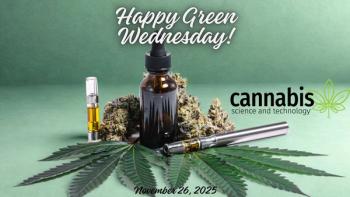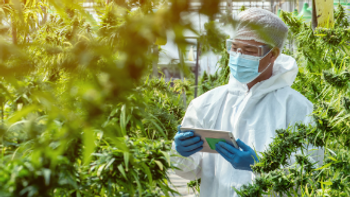
Cannabis Science and Technology
- May 2020
- Volume 3
- Issue 4
Potency Loss in Cannabis Beverages-Common Causes and Solutions
An explanation of the causes of potency loss in infused beverages from either a chemical or physical route.
This article explains the causes of potency loss in infused beverages. The loss can be contributed from either a chemical or physical route. On the chemical side, oxidation could be expedited due to large surface area of the emulsion droplet. Oxidation can also be facilitated by certain beverage base with less control of oxygen during the packaging process. On the physical side, hydrophobic emulsion droplets tend to stick to hydrophobic packaging materials and lose potency over time, for example, an aluminum can liner or polyethylene terephthalate (PET). Using examples that are relevant to the industry, this article explains the root of each issue and then provides best practices to avert or troubleshoot.
Emulsion technology has been used in the beverage industry for years. Emulsification, the process by which hydrophobic substances can be dispersed throughout a hydrophilic liquid, is commonly used by product developers to deliver specific flavors or cloudy appearances to beverages.
For example, to make an orange flavored soda, producers may first make an orange oil emulsion and then infuse it into the soda. If the producer also wants to make the beverage cloudy, to replicate the appearance of fresh squeezed juice, they could use an emulsion with a bigger droplet size to get that effect as well.
When emulsion is used to deliver taste and appearance, expectations and requirements are fairly low. As long as the beverage tastes good and is generally stable, everyone is happy.
Emulsion technology is also widely used in the cannabis beverage industry to deliver active cannabinoids. In this case, much more scrutiny and thoughtful engineering are required.
Why? Because in cannabis beverages, emulsions are utilized to deliver an active ingredient that can change a consumer’s consciousness. This puts an exponentially higher level of scrutiny on the emulsion-the amount of this active ingredient, its intensity, and its impact on the consumer must be highly regulated and remain consistent in order for a product to deliver the intended experience and build long-term trust.
The main challenge for developers and providers of cannabis emulsions is retaining stable potency. There are two major factors that can lead to potency loss-chemical and physical. To pre-empt issues and deliver quality, reliable products, we need to understand these risks and how to overcome them.
Potency Reduction Because of Chemical Loss
Chemically, the potency of a cannabis beverage can be negatively impacted by oxidation. Oxidation will cause a cannabinoid’s chemical structure to change-for example, if tetrahydrocannabinol (THC) is oxidized, it will transfer into cannabinol (CBN). With the loss of THC and the accumulation of CBN-which does not have the same intoxicating effect-the beverage will not produce the promised results for consumers.
The risk of oxidation can be very high because after oxygen gets into water it has a higher solubility in the oil droplets than in the surrounding water. Additionally, emulsification breaks up cannabis oil into billions of tiny droplets, which greatly increases its exposed surface area to oxygen.
Oxidation can also be facilitated by certain beverage bases containing metal ions, such as dealcoholized beer and wine. In addition, oxidation rate is directly related to oxygen control during the packaging process. Lowering the oxygen level from the beverage’s aqueous base and removing oxygen at the final bottling step can be beneficial in counteracting this problem.
To anticipate and avoid chemical potency loss in cannabis beverages, seamless coordination is required between the emulsion supplier, beverage base formulator, and comanufactures. It is essential for each partner to have a clear understanding of how oxidation impacts the beverage’s potency, and of how their work may contribute to this process, to create a reliable and consistent product.
Potency Reduction Because of Physical Loss
Potency loss in infused beverages can occur even if the cannabinoid molecules are not chemically altered. There are a number of physical obstacles that can create droplet loss-these are mostly caused by incompatibility with ingredients, thermal processing, or packaging.
First, let’s take a closer look at ingredient compatibility. To ensure an adequate shelf life, it is fundamentally important that an emulsion does not have active interaction with the other beverage ingredients.
A common example of incompatibility between ingredients and emulsions can be seen in the case of infused red wine or pomegranate juice. These beverages both contain high levels of polyphenol, a chemical compound found in grape skin. When polyphenol encounters polysorbate-a common emulsifier-they will naturally bond and precipitate out, leading to a loss of potency. To avoid situations like this, a concerted effort to test beverage ingredients and emulsion ingredients for compatibility is highly recommended (see Figure 1).
Second, thermal processing can also be a channel for potency loss in cannabis beverages. Thermal processing usually applies high heat-sometimes exceeding 250 °F-or high pressure-sometimes exceeding 80,000 PSI-to eliminate any living microorganism within a beverage. When an emulsion is poorly designed, it may not be able to survive the rigors of this process. If the emulsion breaks down, the beverage can lose homogeneity and therefore impact potency and consistency (see Figure 2).
Third, physical droplet loss can be exacerbated by packaging material. Take aluminum cans, for example. To avoid corrosion or instability caused by direct contact between the beverage and aluminum, a thin hydrophobic polymer is sprayed onto the inner side of the can. The unfortunate consequence of this lining is that it will attract the hydrophobic oil at the center of emulsion droplets, causing them to stick to the liner and drain potency from the beverage over time. Polyethylene terephthalate (PET), the hydrophobic polymer used to make most plastic bottles, has the same effect towards emulsion droplets.
To circumvent this issue, cannabis beverage makers may choose to work exclusively with glass bottles. Glass has a hydrophilic surface, which eliminates this kind of droplet attachment. However, glass is heavy and expensive to ship. The vast majority of producers want to use aluminum cans because of their scalability, lower price point, light weight, and recyclability. To launch a reputable cannabis infused beverage in a can, the emulsion must be tailored to be compatible with liner material thus ensuring minimum potency change.
Conclusion
Between chemical and physical potency loss, it is clear that beverage makers have their work cut out for them in creating an infused product with potency that is effective, reliable, and consistent over time.
The most important takeaway when addressing each of the obstacles outlined in this article is that when it comes to cannabis emulsions, one size does not fit all. Each finished product has its own unique combination of base ingredient, pasteurization method, and packaging material. It would be oversimplistic to believe one emulsion could solve all of those challenges. The best approach is to pick the most suitable emulsion, perform a pilot run, test the stability over time, and accumulate the data. Scientific data is the best tool to build trust for this new cannabis infused product category.
About the Author
Harold Han is the Founder and CSO of
How to Cite this Article
H. Han, Cannabis Science and Technology3(4), 49–51 (2020).
Articles in this issue
over 5 years ago
Best Practices for Pesticide Use in Your Cultivation Facilityover 5 years ago
New Extraction Technologies Lining Up to Be Game-Changersover 5 years ago
Could Automation Be the Next Big Boon to Cannabis Production?over 5 years ago
Azulenes: A Clear Sign of Cannabis Oil Contaminationover 5 years ago
CBD and Horses: Paving the Path for Future ResearchNewsletter
Unlock the latest breakthroughs in cannabis science—subscribe now to get expert insights, research, and industry updates delivered to your inbox.




